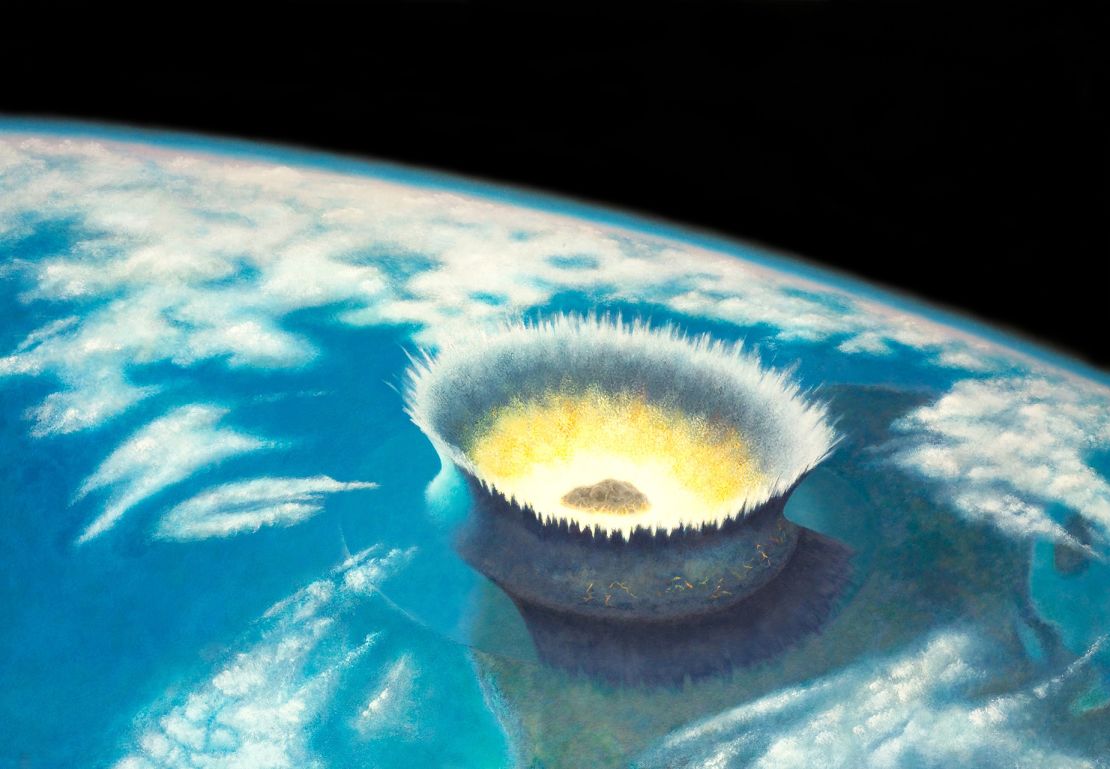Sign up for CNN’s Wonder Theory science newsletter. Explore the universe with news about fascinating discoveries, scientific breakthroughs and more.
CNN
—
Sixty-six million years ago, the story of life on Earth took a dramatic turn when an asteroid slammed into the Yucatan Peninsula in Chicxulub, Mexico. The aftermath of the conflict wiped out 75% of animal species, including most dinosaurs except birds. But there are practically no asteroids.
A new study published Thursday in the journal ScienceResearchers piece together the chemical signature of the asteroid that triggered the planet’s fifth mass extinction event. The dino killer was a rare clay-rich ball of material from the dawn of the solar system, the findings suggest.
Although the Chicxulub asteroid landed several million years ago, learning about this ancient space rock is important because it is “part of a bigger picture for understanding the dynamics of our solar system,” said study co-author Dr. Steven Goderis. Chemistry at the Vrije Universiteit Brussel.
Scientists hypothesized in 1980 Collided with a giant space rock To the death of the dinosaurs. Back then, researchers didn’t find the asteroid; Instead, they found a thin layer of metallic iridium in rocks around the world dating back 66 million years. Iridium is rare in the Earth’s crust but abundant in some asteroids and meteorites.
Some members of the wider scientific community were skeptical of the hypothesis. However, in 1991, scientists determined that the Chicxulub Crater was the exact age of a large asteroid impact that coincided with the extinction of the dinosaurs. Over the years, researchers have gathered evidence that the asteroid strike was indeed the trigger for the cataclysmic event.
The asteroid is huge – probably between 6 and 9 miles (9.7 and 14.5 kilometers) in diameter. But its sheer size is what made it largely disappear. The rock, roughly the size of Mount Everest, hurtled towards Earth, traveling at 15.5 miles per second (25 kilometers per second). According to NASA.

“Essentially, all of this kinetic energy is converted into heat,” Goderis said. “When matter hits a target, it does more than explode; It will evaporate.” The impact created a dust cloud made up of the asteroid and the rock it landed on. The dust spread across the globe, Destroys sunlight and lowers temperatures over the yearsresulting in mass destruction.
As for the asteroid, “there’s nothing but this chemical trace that’s been deposited all over the world,” Goderis said. “It creates this little layer of clay that you recognize everywhere in the world, and it was around the same time 66 million years ago.”
Asteroids (and the smaller meteorites that break them up) come in three main types, each with their own chemical and mineral makeup: metallic, stony, and chondritic. In the new study, Goderis and his colleagues, including the study’s lead author Dr. Mario Fischer-Göde of the University of Cologne in Germany, analyzed the chemical composition of the thin clay layer to unlock the asteroid’s secrets.
The researchers took samples of 66-million-year-old rocks from Denmark, Italy and Spain and isolated components containing the metal ruthenium. (Like iridium, ruthenium is more abundant in space rocks than in Earth’s crust.) The team also studied ruthenium from other asteroid impact sites and meteorites. The scientists found that the chemical makeup of ruthenium from 66 million years ago matched the chemical makeup of ruthenium in a specific type of chondritic meteorite.
“We noticed a perfect overlap with the carbonaceous chondrite signatures,” Goderis said. Thus, the asteroid that killed the dinosaurs was a carbonaceous chondrite, an ancient space rock composed mostly of water, clay, and organic (carbon-bearing) compounds.
Although carbonaceous chondrites make up the majority of rocks in space, only 5% of meteorites that fall on Earth are of this type. “There are some differences in carbonaceous chondrites, too Some of them can smell,” Goderis said. But in hell, when the Chixula effect lands, Goderis said, “You’re unlikely to have time for a good acne breakout.”
Impacts the size of Chicxulub only occur once every 100 million to 500 million years. But because there’s still an outside chance that Earth could be passed by another asteroid or giant meteorite, Goderis said, “it’s good to know the physical and chemical properties of these objects, and to think about how to protect ourselves.” Space rock.

Goderis cited the 2022 DART mission, or Double Asteroid Deflection Test, in which NASA sent a spacecraft to deliberately knock it off course. Knowing how different types of asteroids interact with the physical forces around them will be critical to effective planetary protection.
“Carbonaceous chondrite behaves completely differently from a normal chondrite—it’s more porous, it’s more light and it absorbs more impact if you send an object at it. So, we need to learn about this to get an answer,” Goderis said.
Dr. Ed Young, professor of cosmochemistry at the University of California, Los Angeles, who was not involved in the study, agreed with the findings.
The discovery adds richness to our understanding of what happened when the dinosaurs went extinct, he said. Young noted that the researchers’ assessment that the asteroid is a carbonaceous chondrite is “a strong conclusion.”
Kate Kolumbiewski is a Chicago-based freelance science writer who specializes in zoology, thermodynamics, and death.